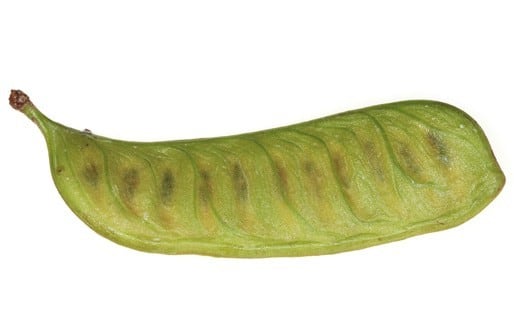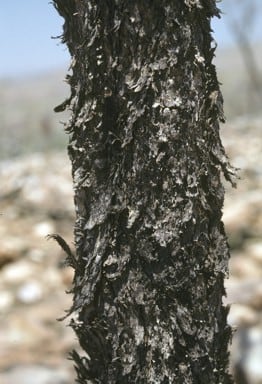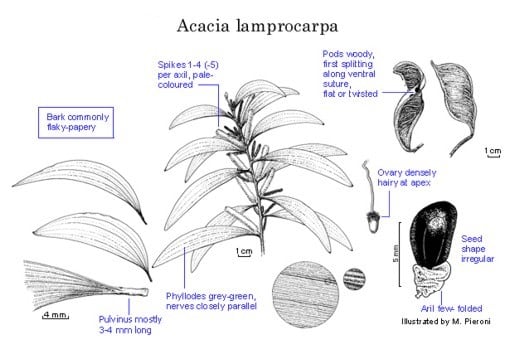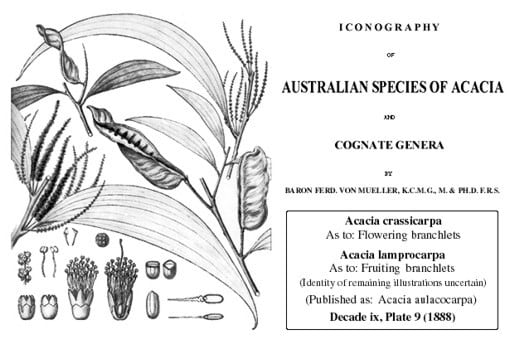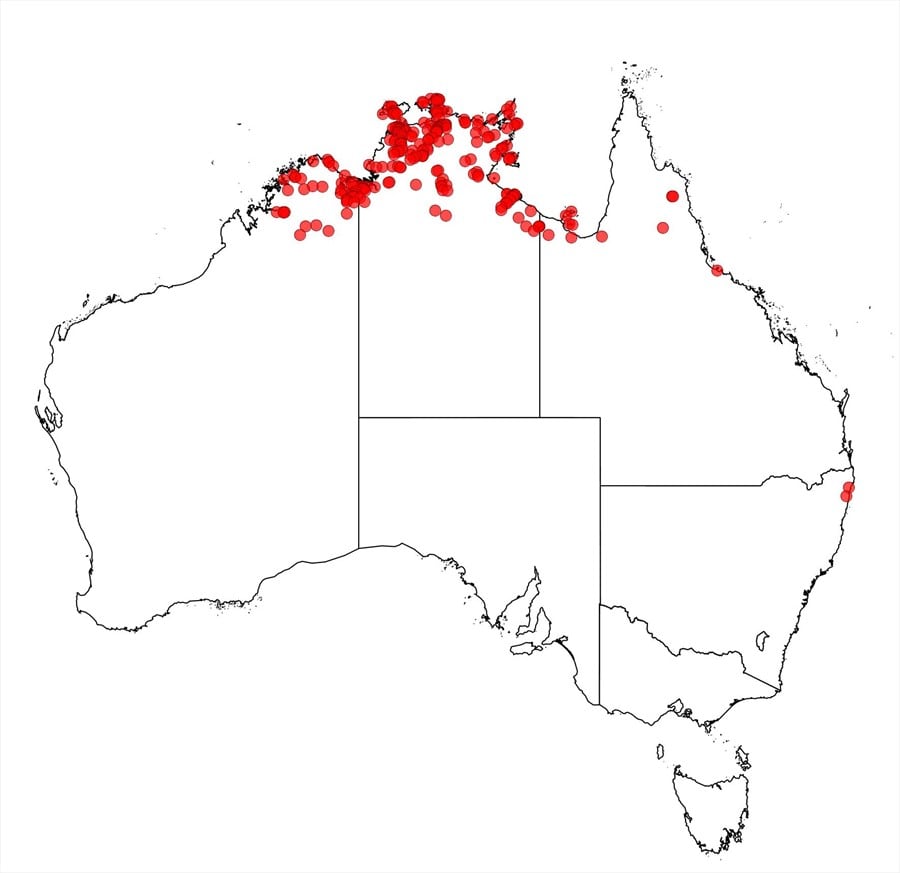Acacia lamprocarpa O.Schwarz
WATTLE
Acacias of Australia
Common Name
Western Salwood
Family
Fabaceae
Distribution
Northern Australia from the Kimberley region, through N.T. to Gulf of Carpentaria in far NW Qld. Occurs on a number of continental islands within this range, e.g. Lacrosse and Sir Graham Moore islands in W.A., Bathurst, Goulburn, Melville, Elcho, Wessels, Groote Eylandt and Vanderlin islands in N.T. and Mornington, Sweers, Andrew and Bentinck islands in the Gulf of Carpentaria.
Description
Trees 3–12 m tall, crowns grey green to pale green. Bark thick, papery, flaky and yellow-brown stems and branches of young to medium-aged plants, becoming dark coloured and shallowly rimose on main trunks of mature plants. Branchlets slender, often pendulous, glabrous. Phyllodes dimidiate to subfalcate, sometimes falcate, 5.5–18.5 cm long, 0.9–3.5 cm wide, glabrous, dull grey-green; longitudinal nerves numerous (4–6 (–7) per mm), parallel, mostly not anastomosing, with 6-8 slightly more pronounced than the rest, the minor nerves slightly raised and normally flat-topped (when dry), main nerves commonly confluent with lower margin for a short distance above pulvinus; pulvinus 3–4 (–4.5) mm long. Inflorescences simple, 1–4 (–5) per axil; peduncles 2–5 mm long, glabrous; spikes 1–4 cm long, almost cream to pale yellow. Flowers 5-merous; calyx gamosepalous, shallowly dissected, glabrous; ovary densely hairy on upper half. Pods oblong to narrowly oblong, flat or 1–3 times spirally twisted, straight to slightly recurved, 2–10 (–12.5) cm long, 1.4–2.2 (–3.2) cm wide, dehiscing along ventral suture, woody, resinous, glabrous, nerves ±oblique and not or scarcely raised. Seeds transverse to oblique, usually irregularly-shaped, often twisted, 4–7 mm long, 3–4 mm wide, glossy, black; funicle/aril with 1–3 folds, 4–6 mm long (unextended), creamy, ageing pale yellow.
Habitat
Grows in a wide range of habitats including margins of watercourses, coastal sand dune systems (including shell banks), sandstone plateaus and on sandy plains.
Specimens
W.A.: Site 1, 16 km W of Mount Anderson, K.F.Kenneally 10392 & B.P.M.Hyland (BRI, NSW, PERTH); The Bastion (E side c. 1 km by road below summit), Wyndham, B.R.Maslin 7190 (PERTH). N.T.: Groote Eylandt, I.D.Cowie 1995 (DNA); 9.3 km S of Nhulunbuy, M.W.McDonald 469 (PERTH); 55 mi. [88 km] of Carlton Hill Stn, R.A.Perry 2989 & M.Lazarides (PERTH). Qld: Mornington Island, 29 May 1963, N.B.Tindale s.n. (AD, BRI); 94.2 km W of Burketown, T.K.Vercoe 203 (BRI).
Notes
A putative hybrid between A. lamprocarpa and A. auriculiformis occurs at Holmes Jungle, N.T.
Acacia lamprocarpa is a member of the ‘A. aulacocarpa group’ and judging from its mode of pod dehiscence is most closely related to A. crassicarpa, A. midgleyi and A. peregrina (from New Guinea). It is distinguished from these and all other taxa of the group by its thick, yellow-brown, papery, flaky bark (which is most evident on young and maturing trees) and its more westerly distribution. Acacia midgleyi is further distinguished by its pale green phyllodes, longer spikes, crustose pods and longer funicle/aril and A. crassicarpa by its lanceolate falcate phyllodes and longer pulvinus and funicle/aril. Herbarium specimens of A. lamprocarpa are sometimes difficult to distinguish from A. disparrimaand flowering specimens resemble glabrous forms of A. difficilis. See M.W.McDonald & B.R.Maslin, Australian Systematic Botany 13(1): 61 (2000), for further discussion.
This species was treated by NSW, Fl. Australia 11B: 168 (2001) as a synonym of A. aulacocarpa but was reinstated as a distinct species by M.W.McDonald & B.R.Maslin, Austral. Syst. Bot. 13: 56–61 (2000).
FOA Reference
Data derived from Flora of Australia Volumes 11A (2001), 11B (2001) and 12 (1998), products of ABRS, ©Commonwealth of Australia
Author
B.R.Maslin
This identification key and fact sheets are available as a mobile application:
URL: https://apps.lucidcentral.org/wattle/
© Copyright 2018. All rights reserved.


